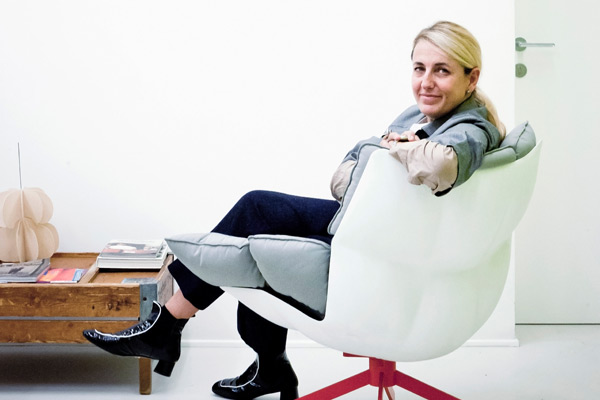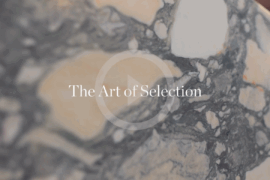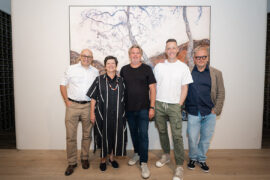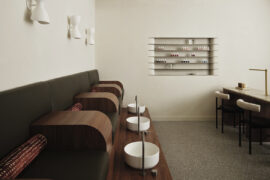Recently in Australia for Space’s 20th birthday celebrations, famed Spanish designer Patricia Urquiola knows the beauty of design. Philippa Daly caught up with Patricia to talk life, practice and passion.

January 7th, 2014
Philippa Daly: What have you learned about design in your years, both as a practice and as a business?
Patricia Urquiola: About business? Nothing! For me it’s a practice; it’s a profession that is only for people who are experimental and who enjoy the process more than the result. For example I began an architectural project for a hotel, and I needed three years to complete the project. Three years! And the process of product design can even take longer. It means that you will be working through a long process many times – not always – but mostly. So if you don’t enjoy the process itself; of going back and forth with the client, different stages of prototyping, playing with new techniques; then perhaps design isn’t for you.
Crossing table for Glas Italia, 2012
Every move you make throughout the process of design impacts on the outcome of the project. Every ‘no’ and ‘yes’ will take the project in a certain direction, and as a designer you are leading that direction. Even with a strong dialogue between you and the companies you are working with, you as the designer have the vital role in the evolution of ideas and directions. Often the idea you begin with is very different from what you get, and the process is a huge part of that outcome. It is important to have a clear intention of why you are designing, and what you are designing, but you also need to embrace the process and be open to the evolution of ideas. In fine art, the process is freer and more explorative, where intention doesn’t play such a big role. With design, we need to be more refined in our approach as our outcomes will often have a practical function. It is the fusion of intension, experimentation and evolution that is key to success in design.
Patricia’s studio in Milan
What I like about design is that the rules are always changing. New projects are coming up more and more that require new techniques, new technologies such as 3D-printing, digital machines and so on. And as long as you have a key knowledge about process, materials, functionality and so on, you can use any method of completion, perhaps easier than you could have before. This opens up a new set of opportunities in itself. For example if you work a lot with moulds, you can experiment with 3D-printing, making the moulds obsolete and changing the process of making entirely.
Husk armchair for B&B Italia, 2011
PD: Having been in the industry for some years now, what advice would you give to yourself as an emerging designer?
PU: I would have told myself to get out of my comfort zone, as much as I possibly could at every opportunity. That’s the only way. I would say to surround yourself with things that inspire you, and connect with that world. When you are young you have less baggage, and are able to learn and absorb far more than you can when you’ve been around the block a few times. You really need to understand how to move your inner compass and take advantage of any opportunity that presents itself. It’s more important to have a compass than to know the way.
Canasta collection for B&B Italia, 2013
I was never a person who had grand goals, I always just followed after what interested and inspired me. And things just fell into place. Curiosity is one of the most important traits a young designer can have. You need to travel, to move, to listen to music, to immerse yourself in as much foreign culture as you can manage, but most importantly you need to open yourself up to any and all experiences, good and bad alike.
The full interview with Patricia will appear in the DQ Autumn issue, out April 17.
Patricia Urquiola
patriciaurquiola.com
Space Furniture
spacefurniture.com.au
INDESIGN is on instagram
Follow @indesignlive
A searchable and comprehensive guide for specifying leading products and their suppliers
Keep up to date with the latest and greatest from our industry BFF's!

Welcomed to the Australian design scene in 2024, Kokuyo is set to redefine collaboration, bringing its unique blend of colour and function to individuals and corporations, designed to be used Any Way!

CDK Stone’s Natasha Stengos takes us through its Alexandria Selection Centre, where stone choice becomes a sensory experience – from curated spaces, crafted details and a colour-organised selection floor.

The undeniable thread connecting Herman Miller and Knoll’s design legacies across the decades now finds its profound physical embodiment at MillerKnoll’s new Design Yard Archives.

For Aidan Mawhinney, the secret ingredient to Living Edge’s success “comes down to people, product and place.” As the brand celebrates a significant 25-year milestone, it’s that commitment to authentic, sustainable design – and the people behind it all – that continues to anchor its legacy.
Iken recently announced the winners of the 2008 Workstation of the Future design competition at Simmer on the Bay, Walsh Bay on 31 July. The design competition has raised some key ideas for what we would expect to see in future work environments.

New Italian brands launch in Sydney. Read on to find out how you could attend the launch event.
The internet never sleeps! Here's the stuff you might have missed

Eco Outdoor recently brought together developers, sustainability experts and local architects such as Adam Haddow to discuss design fundamentals, carbon targets and long-term thinking.

Tom Mark Henry refines a layered design legacy into a softly sculpted retreat in Redfern, where light, tactility and crafted detail define a new expression of restrained luxury.